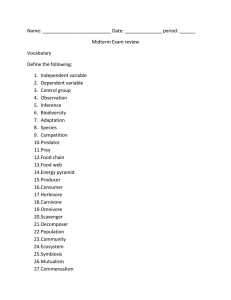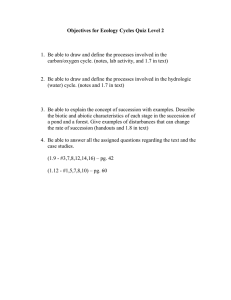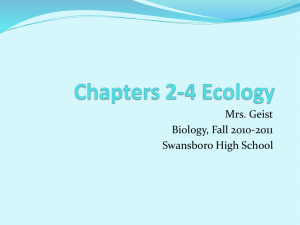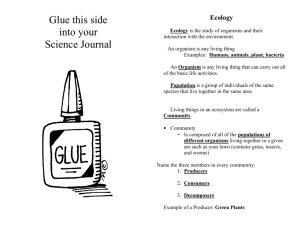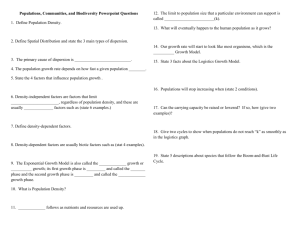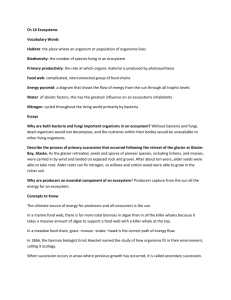Ecosystem Notes 2
advertisement
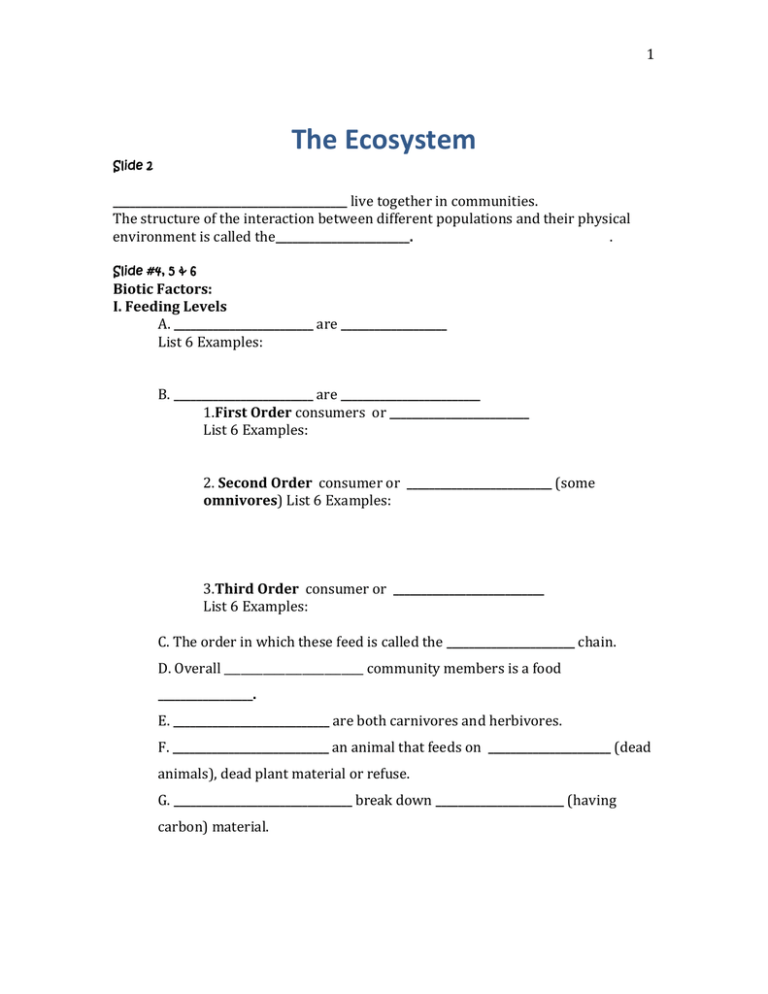
1 The Ecosystem Slide 2 __________________________________________ live together in communities. The structure of the interaction between different populations and their physical environment is called the________________________. . Slide #4, 5 & 6 Biotic Factors: I. Feeding Levels A. _________________________ are ___________________ List 6 Examples: B. _________________________ are _________________________ 1.First Order consumers or _________________________ List 6 Examples: 2. Second Order consumer or __________________________ (some omnivores) List 6 Examples: 3.Third Order consumer or ___________________________ List 6 Examples: C. The order in which these feed is called the _______________________ chain. D. Overall _________________________ community members is a food _________________. E. ____________________________ are both carnivores and herbivores. F. ____________________________ an animal that feeds on ______________________ (dead animals), dead plant material or refuse. G. ________________________________ break down _______________________ (having carbon) material. 2 Slide #7 II. Pyramid of Energy: A. _________________ is lost between each level of consumer (about _______ percent). B. To show this lost a _____________________________ of energy can be drawn C. Potential energy is lost because some energy is _______________ by the organism to carry on life functions. D. Each level is called a __________________ (feeding) level Slide #8 & #9 III. Pyramids of Numbers and Biomass: Most food chains have only _______ links, too much energy is lost to support 4th & 5th order consumers. As the level of consumer increases, the number of consumers _______________________ forming a pyramid of numbers _________________________________ is the mass of living biological organisms in a given area or ecosystem at a given time. Higher feeding levels have _____________ biomass, forming a pyramid. Each ________________________ level receives about ____________________________ of the energy from the previous level. 3 Slide #10 IV. Recycling of Materials: Cycles of Matter A. Matter cannot be __________________________________, therefore it must be recycled. B. _____________________________ (bacteria, fungi) release materials in dead organisms and waste. C. __________________________ (crabs, buzzards, jackals) feed on ________________ (dead animals). Slide #11 IV. Nitrogen Cycle Three pathways of recycling 1. Decomposer bacteria in soil attack proteins in dead animals & waste a. _______________________________ be absorbed by plants b. one group of bacteria converts amino acids to ammonia this is ____________________________________. c. another bacteria then converts ammonia into nitrate ions this is called ____________________________________________. 2. Nitrogen-fixing bacteria live in roots of __________________________. a. plants form _________________________ (a swelling on a root) b. both organisms benefit (___________________________ relationship) 3. Denitrifying bacteria drains nitrogen from an ecosystem by freeing it into the atmosphere. Slide #12, 13, 14 & 15 IV. Other Biotic Relationships _____________________________________ — long-term interactions between different biological species. Three Types 1. _____________________________________ 2. _____________________________________ 3. _____________________________________ 4 IV. Other Biotic Relationships (cont.) 1. _____________________________________ one organism benefits from a host without harming or benefiting host. 2. ____________________________________ is when two organisms depend on each other and both benefit. 3. ___________________________________ is when one organisms is completely depend on the other at some point in its life cycle and ___________________ the host. Slide #16—#17 V. Abiotic Factors of Environment: I Medium A. Substance in which an organism lives. B. Density C. Gas exchange Slide #18—#17 II. Water A. Water cycle or _____________________________ cycle B. Amount of rainfall determines distributions of _________________________ or land plants. C. Water _________________________________________ from ocean and forms clouds. D. Water falls from clouds as rain (______________________________________). E. Water will hit the ground and then… i. ________________________________ from surface forming lakes and rivers. ii. Seeps (_______________________________) into ground becoming __________________________ ____________________________________. F. Water is taken into plants & (as a by-product of ________________________________) is given off (__________________________________________) in the form of water vapor. G. Water also ______________________________________________ from lakes and rivers. 5 IV. Other Biotic Relationships (cont.) III. Soil A. Rock breaks down by ______________________________. B. ____________________________________________ is the process of chemical or physical breakdown of the minerals in the rocks. Example: rain C. Rock mixed with decayed organic material is called ______________________________. D. Soil forms layers, the layer closest to surface is called ______________________ and is high in organic material. IV. Light A. _____________________________________--- exposure B. Only _______________—________________ percent of total solar radiation (light striking earth) is used for photosynthesis. Slide #23 V. Temperature & Metabolism A. As temperature changes so does metabolism. B. Limits where life can live Usually between 0° C to 50°C C. _______________________________ (also spelled estivation) is the response to hot or dry conditions sometimes called summer dormancy D. ______________________________ winter dormancy. Slide #24 &#25 V. Distribution of Organisms A. Succession is how community changes over time. B. As a community ages it goes through different stages. C. The type of plants are the key to the stage the community is in. D. Two types of succession a. _______________________________ succession (first) b. .______________________________ succession (areas that have been disturbed) Slide #24 &#25 V. Distribution of Organisms (cont.) _________________________________ succession (first) 6 1. Begins when _______________ ________________ is formed, like lava or when rock is exposed for the first time. 2. ____________________________ ________________ take hold in this new environment. a. These are _______________ _____________________________ b. Examples i. __________________________ (symbiotic relationship between algae and fungi) ii. _________________________ 3. __________________________________ community a. This is a community that has reached a ______________________ ________________ under a particular set of environmental conditions. b. These are the ____________________________ communities resulting from succession, and the represent the community which makes the most ___________________________ _________________ of available resources. _____________________________ succession a. Occurs on substrate that previously supported vegetation before a _____________________ destroyed the plant life. b. Is a _______________________________________ to a disturbance, for example, forest fire, tsunami, flood, or an abandoned field.
